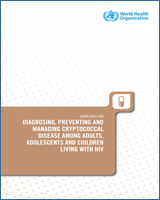| Certainty of evidence | A systematic review found one randomized controlled trial, and the evidence was considered to be of moderate certainty. | Moderate |
| Balance of benefits versus harm | The evidence indicated that the single high-dose liposomal amphotericin regimen was non-inferior in terms of 10-week mortality to the current WHO-recommended treatment of seven daily doses of amphotericin B deoxycholate (1 mg/kg/day) plus flucytosine (100 mg/kg/day) followed by seven days of fluconazole 1200 mg/day and that the liposomal amphotericin regimen was associated with significantly fewer adverse events. | Benefits outweighs harm, with benefits being considered large, and reduction in harm being large to moderate in relation to the comparator. |
| Values and preferences | Qualitative data from a purposively selected group of participants, surrogate decision-makers and researchers working at the sites in Gaborone, Botswana and Kampala, Uganda identified a clear preference with regards to the administration and tolerability of the single-dose liposomal amphotericin regimen. The liposomal amphotericin regimen was favoured because it involved a single intravenous dose which, despite taking longer to prepare on the first day of treatment (20–40 minutes versus 5–10 minutes for amphotericin B deoxycholate), was less time consuming over the course of the induction therapy. In addition, liposomal amphotericin can be administered over two hours, whereas amphotericin B deoxycholate must run over four hours. Fewer intravenous doses of amphotericin resulted in a reduced need for essential pre- and post-hydration and oral electrolyte supplementation aimed at preventing toxicity. Liposomal amphotericin was subjectively observed to result in fewer and less severe infusion-related rigours, but this was not objectively measured within the trial. | No important uncertainty or variability of preferences. |
| Acceptability |
Qualitative data from a purposively selected group of participants, surrogate decision-makers and researchers working at the AMBITION trial sites in Gaborone, Botswana and Kampala, Uganda (LEOPARD study) identified a clear preference regarding the administration and tolerability of the single-dose liposomal amphotericin B–containing regimen.
There was a general preference for the single-dose liposomal amphotericin B regimen because it was associated with fewer intravenous doses. The single intravenous dose took longer to prepare on the first day of treatment, but the entire regimen was less time-consuming to administer over the course of the induction therapy.
| Acceptable to all stakeholders. |
| Feasibility | The short-course high-dose liposomal amphotericin regimen requires just a single intravenous infusion versus seven with the current WHO-recommended regimen and has significantly fewer side-effects. As a result, it may be feasible to reduce the duration of hospital admission in some cases, and the need for toxicity monitoring is reduced. Unlike amphotericin B deoxycholate, liposomal amphotericin B does not require refrigeration. The short-course treatment would be feasible to implement in all settings in which amphotericin B deoxycholate treatment is currently being used and could be implemented in some settings that are currently unable to implement seven-day courses of amphotericin B deoxycholate. Further, the intervention does not require refrigeration. The Guideline Development Group noted limited access to flucytosine, which is part of the induction therapy for cryptococcal disease and expects feasibility to improve with this recommendation. | Probably feasible |
| Cost-effectiveness | A detailed costing and a cost–effectiveness analysis was performed alongside the AMBITION trial and estimated that the mean total costs per person (using Malawi as a reference case) were US$ 1369 in the liposomal amphotericin B group and US$ 1237 in the control group. The difference between groups was US$ 132 (95% CI US$ 53–211) and the incremental cost–effectiveness ratio was US$ 128 (95% CI US$ 59–257) per life-year saved. Excluding protocol-driven cost, using a real-world toxicity monitoring schedule, the cost per life-year saved declined to US$ 80 (95% CI US$ 15–275). Cost–effectiveness was robust in sensitivity analysis, including those assuming higher drug costs. | Probably favors intervention |
| Resource use | The Guideline Development Group indicated that costs could change based on settings and may not be available in some countries, such as those from the WHO Region of the Americas. Also important to consider is that the intervention is part of a three-drug regimen – with flucytosine and fluconazole (both comparison and intervention), there is some variability in access prices at the time of the guidelines meeting (liposomal amphotericin varied between US$ 17 and US$ 83 in the surveyed countries per vial, flucytosine varying between US$ 0.50 and US$ 2.32 per 500 mg, Fluconazole varied between US$ 0.04 and US$ 0.25 per 200 mg), and MSF and the Global Fund reported more consistent pricing. The expected price of the entire WHO-recommended regimen with conventional amphotericin is about US$ 145, and with liposomal amphotericin about US$ 502. The costs reported from the AMBITION trial were US$ 340 for the regimen per person. | Resource requirements may vary based on setting. |
| Equity | Implementing the short-course high-dose liposomal amphotericin regimen could increase access to effective treatment for HIV-associated cryptococcal meningitis for people at health-care facilities unable to safely administer seven or more days of amphotericin B deoxycholate treatment. The PADO group noted that use may be extrapolated to children, and therefore improving therapeutic options for children living with HIV, who would not have to receive conventional amphotericin therapy. | The impact of the intervention will probably increase equity across population subgroups. |

